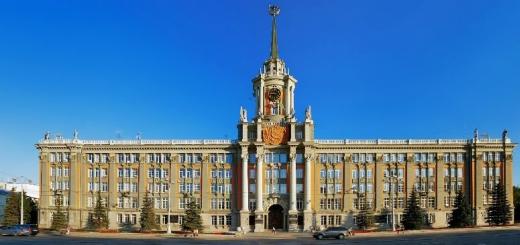I continue the story of river vessels built during the first five-year planks of the USSR. Information on them - for the most part - taken from the magazine "Technique - Youth".
After completing the recovery of the river fleet during the first five-year period, the period of its reconstruction began. Now, before ships, the task was not only to replenish the shipping courts by the courts of Soviet buildings, but boldly introduce advanced techniques to reduce the timing of the facilities of the courts, reduce the consumption of deficient metal and, therefore, the costs of them. One of the progressive methods in those years was electric welding.
In fairness, we note that it was invented in 1881 by the Russian engineer N. Benardos, and six years later, N. Slavyanov improved, who created the first welding shop on the Perm steel and cannon factory. However, for a number of reasons, electric welding has not found wide use recent years World War II. Its "second birth" she is obliged to reasons for a purely military nature - the need to save metal and accelerate the production of military equipment in everything.
In shipbuilding, one of the initiators of the application of the new technology was Professor V. Vologdin. It was in 1926 that he successfully conducted the first experiments first on the welding of the barge, and then individual nodes and parts of ships - the foundations of cars, fuel and ballast tanks, all sorts of casing, boat, cargo arrows. Then the group of Vologdin has developed an apparatus intended for the manufacture of internal bulkheads. In 1929, the employees of the Kiev Machine-Building Institute completed its tests, and in a centralized organization that was engaged in the design of new vessels, the department appeared, whose staff began developing welded ship structures, the introduction of electric welders on the shipyards and training of workers and welders.
Preparatory stage research work Completed by the beginning of the 30s, and the Board of All-Union Association of River Shipbuilding entrusted the construction of the first in the country of the All-welded vessel of Kiev shipyard (now the Lenin Kuznik plant).
The Kiev residents elected the object of the experimental building already developed by the industry and a well-proven towing tug with a steam engine with a capacity of 150 liters. with. It was designed by the designers of the Nizhny Novgorod plant "Red Sormovo" to tow the rafts on the northern rivers from the areas of logging to the seaports.
Starting such an unusual experience, Ukrainian ships deliberately refused to make any changes to the project - an externally, a new tug was not different from their fellow. The same flat-bottomed, with a housing, divided into five compartments by four waterproof bulkheads, side rowing wheels, straight sides, with an angular superstructure, crowned with a long smoke.
Workers drawings "Belarus" - such a name was received by the towing were prepared by August 1, 1931, and two weeks later laid the first sheets of the bottom. Then began installation of set, trim, add-ons. Everything seems to be as before ... Yes, only for the first time on the stapel, there was no deafening rumble of rivet hammers, and the dazzling flame of an electric arc ghostly broke out. For the first time, the vessel under construction in the planned places was installed ready knechti, calends, portholes and other parts, and not mounted them in parts, as before. The work went unusual quickly, and on November 20, a new tug was solemnly transferred to the owners - Dniprovsky Ricnics. The labor watches of the steamer "Belarus" began. And at the Red Sormovo plant, the same type tug "Welder" was built in the same way. And shipbuilders began to sum up the experiment. Well, they turned out to be quite good. Suffice it to say that the "Belarus" building was 27.5% easier than the riveted tugs - the metal savings are evident. In addition, for the first time, shipments were able to do without a number of rather heavy, which occupy a lot of operations. It is about the abuser of the holes in the sheets of the sheath and the housing, the riveting itself, the chasing; Finally, the need to make thousands of different-caliber bolts and nuts - labor-intensity of work decreased by 30%. The advantages of electric welding turned out to be obvious.A new way to build vessels immediately distributed to other enterprises of the industry, and the Kiev Plant "Lenin Kuznitsa" began an extensive program of design and construction of a large series of all-welded tugs with a capacity of 150 and 300 liters. with. Following the Ukrainians, electric welding was promptly implemented on many shipbuilding and repair enterprises of the Volga basin.
From the mid-70s, the passenger fleet of the Black Sea Shipping Company was actively updated. Courts were built, including in Finland, which at that time was a law legislator in the construction of passenger ferries
The ship "Belarus". BlackSeaNews.net
Thus, in the Finnish city of Turku at the shipbuilding shipyard "Vyartsil" in the construction there were five of the same type of autopassy ferries, intended for the Black Sea shipping. The head ship was assigned the name "Belarus", the second - "Georgia", the third - "Azerbaijan", the fourth - "Kazakhstan", the fifth - "Karelia".
Almost half a century, these ships were separated from the former passenger "Crimea", a lot has changed over the past years. The demand has grown out travel travel According to the Black Sea, the area of \u200b\u200bthe swimming of passenger ships, especially in the fall and winter, expanded.
The inclusion of vessels of this series into the Passenger Fleet of CMP meant a high-quality jump. It demanded the introduction of a number of organizational and technical innovations. The ports of the Crimean Caucasus line arose the need for equipment of special "corner" berths for the possibility of mooring vessels like "Belarus" and the opening of the ups. Should also develop and implement the technology of accumulation and loading of cars, containers, etc.
New boats for the comfort of passenger premises and shape differed significantly from their predecessors of the construction of the thirties: a calm straightness of the body and the add-ons changed the dynamism of the regiments.
Beveling superstructures, bent back mast and the pipe with wings gave "Belarus" rapid and elegant look. When designing the vessel, special attention was paid to providing passengers with maximum amenities, to create a coziness atmosphere and good conditions for relax.
Belorussia had a deadweight 3000 tons; length - 157 m; width - 21.8 m; Sediment - up to 6.2 m. Power of two main 18-cylinder diesel engines - I8000 hp With a rotational speed of 520 revolutions per minute allowed to develop speed up to 2 s. To reduce dipping, the motor ship had stabilizative devices. There was a piring device, a nasal, aft and onboard guns.
Initially, the ship was 173 passenger cabins for 480 people. On the autopalub could accommodate up to 250 passenger cars. In 1986, the vessel was converted, the passenger capacity increased, additional cabins were built.
His name "Belarus", as a banner, picked up at the famous steamer of the Far Eastern steamer. By the same name transported national economic and military goods to the Arctic, in the most difficult conditions of military time made his way as part of caravans, overcoming ice and enemy confrontation.
In March 1944, a steamer "Belorussia" under the command of Captain K.G. Kondratieva followed the cargo from the United States to Vladivostok. In the area of \u200b\u200bITUURUP ( Kurile Islands) It was torpedoished and surrounded by the Japanese submarine. Alive miracles remained two crew members: Kochegara I.P. Petrovichy and Ya.P. Heat. 41 people died.
On January 15, 1975, the state flag of the USSR was raised on the head vessel of the series of autopassazhire ferries - the Government of the Belarusian Flag of the USSR. In early February, the crew was completed in Riga, the vessel supplied for the upcoming passages. At the same time, the first visit to Belorussia Vladimir Vysotsky, friendship with which the crew had a long time.
The motor ship accepted one of the most experienced captains of CMP Felix Dashkov. Before that, he commanded the Lithuanian ship, perfectly proven himself while working on international line Odessa - Marseille. Reached on "Lithuania" the level of Dashkov's service moved to Belarus and did a lot to improve comfort, the good new vessel was a higher class.
Belarus began its work in cruises with tourists of the West German firm "Tourop" on the route Genoa - Canary Islands. Swimming on this route during the cold season lasted for many years. Since 1977, such constant in the summer months was work on the Marseille line. In addition, the ship went through Crimean-Caucasian, Middle Eastern lines, carried out cruises around Europe.
In the 1980s, the charterer made West German "Dolfin Zeeraisen" and the French "Transstur of the Company". The vessel began to make Arctic cruises with an approach to Svalbard. Worked "Belarus" stably trouble-free. Annual income from operation amounted to several millions of foreign currency rubles.
There were also unforeseen cases. So, in October-November 1979, the ship carried out cruises to the United States with Soviet tourists. At the transition of Boston - Baltimore, the ship shouted with its bulb-like whale-like 12 meters long. Main engines were stopped. To get rid of carcasses, I had to call the port tugs that fascinated China and pulled it from the Forest.
Belorussia was repaired first in Yugoslavia, and since 1977, the Odessa CPZ "Ukraine" has mastered and successfully produced a dock repair of ships of this series. In February-May І986, the ship was modernized in Bremerhaven.
Flights "Belarus" visited a lot famous peopleFor example, the outstanding Soviet writer Konstantin Simonov. In I975, in 1977, Vladimir Vysotsky and Marina Vladimir Vysotsky and Marina said on the vessel. The crew tried to do everything so much expensive guests were satisfied. And Vladimir gave their wonderful songs to sailors and tourists.
Before the collapse of the USSR, the financial and economic situation in CMD was stable, but since 1992, the shipping company began to feel the consequences of non-payments and crisis phenomena, became the debtor itself. It was at this difficult time "Belarus" fell into the largest accident. On October 25, 1992, at the ship repair plant in Singapore, a rise was made to the Doc "Belarus". The motor ship arrived at the planned repairs and reported under the command of Captain I.N. Mironenko, who headed the ship since 1980. In Singapore, a valued crew arrived.
In the process of setting to the Doc, when the vessel was already on the keel-blocs, the motor ship suddenly faltered (as it turned out, several "pillows" of Kiel-blocks were made in Pontoon) and fell first on the left, then it became more importantly to roll on the right side. There was a strong roar. From the docking tower, two lifting cranes collapsed on the adjacent plander.
The dock workers fell into the water, like peas: the vessel tipped along with the dock. Captain Mironenko announced a public alarm and organized the evacuation of the crew. The coastal crane filed a "gazebo" and began to take off the team, half of which were women.
The neighboring dock was impoverished, the cranes on his towers, until they threw them, slowed down the Roll of Belarus. The ocean tug rewicked alongside the next time, otherwise it would have got him.
After the onset of full water, the ship's roll reached 52 degrees, lusted to the dock the ship received serious damage. Then the position of the vessel together with the dock stabilized. However, in ship premises, there was a significant amount of water, the cabins of the lower decks were flooded, where the crew was located. Mazut spilled out of fuel tanks, stuff swam in rainbow divorces. It was the first in the history of the Fleet ChMP, the case of overturning docking along with the vessel.
On November 14, it began to hide the vessel with the help of two powerful floods. After that, 19 pumps pumped out water from flooded premises. The vessel was then put in a dry dock for restoration and repair work, which continued until May 1993.
Later it was decided to direct the ship to Bremerhaven to complete the repair. This decision can hardly be called appropriate, since CMP was already indebted to the company Lloyd Verft, where the repair was planned, and the production of Belarus raised this debt to 24 million German brands. Repair in Singapore would cost much cheaper.
As a result, the repair affairs ended with loud financial scandals, criminal cases were discovered, the "Lloyd Verft" claims stated to the claims of creditors of other companies, which even more complicated the financial situation of the CMP. By the way, the arrest of the "Odessa" ship in April 1995 in Naples was performed on the suit that Lloyd Verft.
Repair of "Belarus" was completed in December 1993. The ship was renamed Kazakhstan-2 and continued cruises. In July 1995, the vessel was detained in Port Troms representatives of the International Traffic Workers Trade Union. The basis of the delay was the lack of a contract with a shipowner's crew and the fact that the crew receives a salary is lower than the level established by the Union.
In 1996, the Liberian flag was raised on the ship. According to some reports, the ship "Belarus", called Dolphin at the beginning of 2012, still worked as part of a small German company. Commanded by him Captain Vladimir Vorobiev, who, by the way, was once on the "Belarus" by travelers.
This is the history of the ship, which has successfully worked in the Passenger Fleet of the Black Sea Shipping Company.
Vladimir Polyakov,chairman of the Council of Veterans Fleet ChMP, Senior Mechanic,
Oleg Bulovich,deputy Chairman of the Council of Veterans of the Fleet ChMP
Ports of Ukraine, №7 (119) 2012
If you have noticed an error, select the necessary text and press Ctrl + Enter to report this edition.
The length of the waterways of Belarus is 2.5 thousand kilometers. The country is small, the car roads are good, so internal transportation by river transport, although there are, but develop weakly. While. Today, Belarus actively leads to the modernization of waterways to meet the requirements of European qualifications. Transit is an excellent prospect. Large-scale projects stimulate the development of regional: enthusiasts at this year organized the first shipping festival in Belarus.
Back in the 1950s, the idea of \u200b\u200bcreating a trunk - from Dnipro to Vistula - the paths of international significance with the designation E-40. The start of the "new old" idea is given in the spring of 2014 in Brest. Then a memorandum was signed between Belarus, Ukraine and Poland about the recreation of the path of Dnipro - Bug - Vistula - Oder. There is an active work, and in December 2015, the 3rd session of the Commission on the Development of Water Transport Connection E-40 on the Dnipro section - Vistula will take place in Lublin. There will be a feasibility study of the project. This is the first stage. There will be money, the second - design will begin. And only then - the implementation.
Recently journalists of Belarusian and foreign funds mass media Interested organizations showed how hydrotechnical structures are updated in Belarus. Due to the budget.
Five of 11 hydrauses are already reconstructed. They gained the second life and meet the high parameters of the international classification. Take, for example, hydraulic cobrin. The largest in the country, with a water drop of 5 meters of 40 centimeters. Previously, the process of sliding occupied more than an hour, now - about 15 minutes.
However, 15 - 20 ships per month through the hydrousel. Not much...
Now the Belarusian rivers are transported to 1 million tons of cargo. The plans are at least four million. Crushed stone from Mikashevichi, sand, potash salts from the Petrikovsky field ... There are two oil tankers on the Pinsky shipbuilding plant, which will be used to transport petroleum products from Mazyr to Brest.
Belarus is interested in transit. And for Europe, an additional transit thread on water as it is impossible by the way.
The creation of a new way "From Varyag in the Greeks" with a length of more than 2 thousand kilometers prevent several running river sites. From Brest to Kherson, you can go through the water. A narrow place is a section of Western Bug from Brest to Warsaw. In Brest - a deaf dam. Next is the wild river without hydraulic structures, without way work and clearing. There are three options for restoring the site to Warsaw. As well as several options for the compound of the Polish (future) shipping site with Belarusian.
When it is possible to freely get from Baltic Sea In black and vice versa? The question of time and not one hundred million dollars.
Cargo transportation on rivers is cheaper than on the ground. But the passenger river transport is not cheaps. Today on the balance of Belarusian river shipping company 10 passenger ships. Pleasure. Rice on water in Brest, Pinsk, Mogilev, Gomel and Rechitsa, as well as on the Zaslavsky reservoir. For the navigation period, just over 99 thousand tourists were transported. Less than last year.
But the ships for walking with passengers do not yet use the E-40 water. Although there is infrastructure for such hydrauses. Perhaps the first will test new water opportunities cruise ship For tourist and excursion transport, which will run on the route Brest - Kiev. A ship with a length of 43.6 and a width of 7 meters, with a restaurant and a casino, completes the Pinsk shipbuilding plant. Next year - descent to water. Secretary of the Commission on the Development of the Water Transport Connection E-40 on the Dnieper section - Vistula Andrei Roshke noted that the cruise ship is not a passenger ship for the delivery of passengers from point A to point B, so it will go with a speed of no more than 20 kilometers per hour, and The pleasure of traveling on it will be expensive.
While big plans are waiting for big money, enthusiasts act. In 2015, the first shipping festival was held in Belarus. Small fighting switches "Yatvant", built by three reconstructors from Lida, tested Nemman's water. The owners of the agricultural district from the Kobrinsky district with the help of artisans built a ship "Slapnir" (sliding, magical octopic horse in mythology). Recently, the test descent of the vessel on the water and swim along the Mukhaver River.
Probably standing for the oars in a good company and see tourist routesthat offer owners of the agriculture. But - in the spring. This year navigation is completed ...
Shipping in Belarus It is performed only by rivers and lakes, as the country has no way out to the sea. The length of the waterways of the Republic of Belarus is about 2.5 thousand kilometers.
However, the whiserists of these ways for domestic transport in many cases inexpedient. This is due to the fact that on the territory of Belarus is usually only the upper large rivers (for example, Dnipro, Western Dvina, Neman, et al.). First, not all of them shipping (only on the largest water arteries of depths reach 1.5 meters). Secondly, they are usually concentrated along the perimeter of the republic (Dnipro - Eastern and South-Eastern, South, South, Bug - South-West, Nemman - North-West, Western Dvina - Northeast Parts of Belarus).
At the same time, in the central part, shipping inland waterways are practically absent.
The waterways of Belarus are in no way interconnected (with the exception of Dnieper, Pripyat and Bug).
The small size of the state and the fairly developed network of roads, does not contribute to the growth of domestic transportation volumes by river transport.

Dnipro-Bug Channel
Theoretically, it is possible to use all major waterways of the republic (Dnipro, Pripyat, Bug, Western Dvina, Neman) for international river shipping. Currently, there are only one waterway exploited in one direction in Belarus - this is a system of Bug - Pripyat - Dnipro - Black Sea. The end of the years appeared the idea of \u200b\u200bcreating the Main Waterway of North-South, which includes the Vistula, Bug, Pripyat, Dnipro (so-called. The path is 40), with a possible connection to it (through the city of Yogin, Oginsky Channel and Phara) Neman, included in the European Economic Commission in the draft European Agreement on the most important inland waterways of international importance.
Project work is underway. Of course, the construction of this main path will require quite considerable costs. Moreover, the main part of their costs is necessary for the territory, where the depths on most of the parts of the Vistula and Buga baggage are barely reach one meter, while according to the requirements for waterways of the category there is a minimum depth should not be lower than 1.2 meters. The Belarusian segment, with the exception of several sites, meets these requirements. The bypass channel around the dam was dug around the dam in the Brest area, which eliminated obstacles on the way of shipping by p.
1. River ports and pier
In total, there are 10 river ports in the country. River ports Gomel, Bobruisk, Mozyr have railway access roads and are adapted for handling goods acting in a mixed direction. The port economy is equipped with floating and portal cranes, cargo mechanized lines of high-speed vessels.












